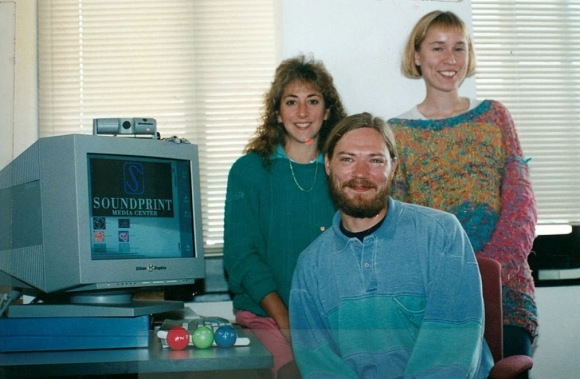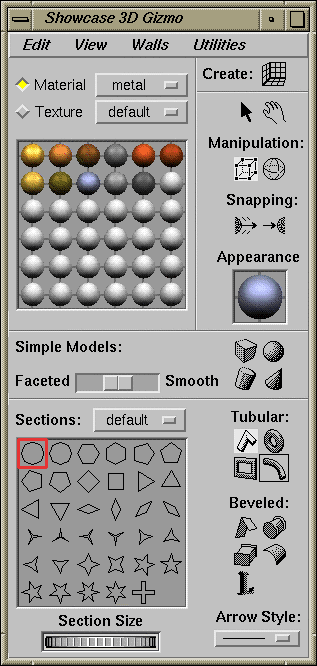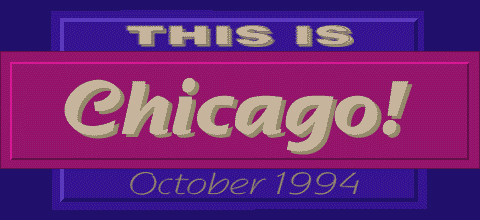[20 Years Ago, Part 10. Other options: prior post or start at the beginning.]
The big day was finally here. I’d made it down from the city ahead of the rush hour, and arrived at SGI well before the start of the exec team meeting.
I headed down to the Building 6, where the execs had their offices, and found the Board Room. Meeting me there was David Ciemiewicz, a.k.a. “Ciemo,” an engineer as passionate about the web as I was, who had in recent weeks gone from being a friend and occasional technical advisor to becoming essentially the technical co-founder for the new business we hoped to get green-lit. And this morning, he would also be handling an important, if not glamorous task — hitting Page Down to advance the slides of the Showcase presentation, so I could focus on speaking.
The Board Room was enormous and brightly lit, with a long table running most of its length. Ciemo went about getting the presentation on the Indy, while I stashed my props in the belly of the lectern at the head of the table. After a quick run-through of the deck, we exited the room and camped out in small waiting area outside.
We’d end up being there for a while, as our presentation wasn’t scheduled until after the weekly conference call with country managers. Soon, the execs started showing up for the meeting. Though almost none of them recognized me (and vice versa), most of them knew Ciemo, who had been at the company for eight years, so there were a lot of smiles, greetings, and small talk as they headed in.
I was on the lookout for one of the few execs that I actually did know, our division’s GM, Tom Furlong. You see, I hadn’t had a chance to let him know about my last-minute addition to the presentation. By the time Tom arrived, the Board Room was more than half full, as the meeting was only a few minutes away. “All set?” he asked.
“Yep,” I replied, “But I need to tell you something.”
“Shoot,” he said.
“I’m sorry I didn’t get to discuss it with you in advance,” I said. “But last night I decided to end the presentation with a request for investment.”
“How much?” he asked.
“Three million.”
“Okay,” said Tom, with a bit of a chuckle. “Good luck with that!”
He headed into the Board Room, leaving us to ponder whether he thought I was smart or crazy.
After all the execs made it in, the doors closed, and the long wait began. The country manager call took something like 30 minutes, but it felt like an eternity. Finally, the door opened, and Ciemo and I entered a room that now looked dramatically different. What had been bright, empty, and roomy, was now mostly dark and jam packed with people. The long table was full, with five execs on each side and another two on the end. And the back of the room was crowded with another dozen or so folks, including each division’s director of marketing.
Ciemo got the presentation up on the big screen, and I took my place at the lectern, which was now in the only brightly lit part of the room. A few small lights above the table provided just enough illumination for me to see the faces of the execs. Everything else, including all the folks at the back of the room, was in near total darkness.
I looked around the table, and made eye contact for the first time with the company’s President and COO, Tom “TJ” Jermoluk. He sat halfway down the left side of the table. His blond hair and relaxed confidence gave him a surfer vibe. He gave a big smile and said, “Let’s go.”
No recording was made of this presentation, and the digital copies of the Showcase file have long since been lost. All that remains, aside from memories, is one color photo that I used to illustrate one of the slides. But here’s what I remember of the pitch…
After introducing myself, I started with a slide introducing the World Wide Web, illustrated with example web pages.
“The Internet has been around for 25 years,” I said. “But recently it has entered a new phase of explosive growth. Why? Because the Web makes the Internet visual, media-rich, and interactive. And that makes it both compelling and easy and to use. In the process, it is now creating one of the fastest growing new markets for visual computing…”
I should probably point out that I did not have a script or notes, and that this was a true SGI-quality presentation, which is to say that there were no words on the slides other than titles. But my pitch flowed like water that morning 20 years ago, as I was delivering a narrative I felt deep in my bones.
“Let’s take a look at what I mean by fast growth,” I said, and Ciemo brought up the next slide, showing a graph1 that looked something like this:

“By every important measure, the World Wide Web is growing exponentially. The number of websites is now doubling every three months! And here’s why that growth will not slow any time soon…”
From there, I showed and talked about a virtuous cycle. (More people getting online, inspiring more websites to be created, leading to more compelling content, leading to more people downloading the browser and getting online, and on and on.)
“As that cycle continues,” I said, as we advanced to the next slide. “It’s giving rise to two ‘picks and shovels’ market segments, that we should not only enter, but that we should, in fact, lead. Those segments are web authoring and web serving.”
“On the authoring front, I should say that I’ve been incredibly frustrated by our experiences in the multimedia authoring market. With Macromedia unwilling to port to IRIX, we’re frozen out of the main action. But with the web authoring market, we have no such disadvantage. In fact, we can (and should) jump in, feet first, and create a visual, media-rich HTML authoring system that highlights the differentiation of our workstations. But even if we don’t do that, we don’t have to stand on the sidelines. SoftQuad, a small software company in Toronto, has created the very first HTML editor and is open to a deal to port it to IRIX.” I paused, reached down into the belly of the lectern, and pulled out my first prop, a shrink-wrapped box of software. “It’s called HoTMetaL Pro, and it’s currently available for Solaris2.”
“Can I see that?” asked TJ.
Attention quickly shifted, first to TJ, then back to the box in my hands. I leaned forward and handed it to the exec seated closest to me on the left. It was quickly passed along to TJ. The room was silent as he slowly examined all sides of the box. “Why don’t we make something like this?” he asked, looking around the table, and then handing the box not back toward me, but to the exec to his left. For the next couple minutes, each VP repeated the little ritual of accepting the box, examining it carefully, then handing it to the guy to his left.
As the box made its way around the room, I returned to my pitch, shifting over to the web server market. Here, I would have emphasized the central role of Netscape (the company having just renamed itself the prior week), and the incredible good fortune of having our recently departed founder, Jim Clark, at the helm there; and them using Indys as their development environment and as the server hosting the downloads of the browser. It was a hot new server market being born on our platform; we just needed to license their server software and bundle it.
I laid out my proposal, at high level, to enter these two market segments with a new product line, comprised of workstations and servers, bundled with all the right tools for kick-ass, media-rich web authoring and serving. To make it more tangible, I teed up a product line slide by saying, “Introducing Spider from Silicon Graphics.” The slide made it look like the product line already existed and was already supported by print advertising. And then I reached into the lectern to get my second prop, the black plastic Indy shell. Holding it up, I said, “And the entire product line will come in black.”
I paused, hoping TJ would chime in, but instead, someone from the other side of the table piped up. (I would later find out that it was the company’s VP of Manufacturing.) He said, “I have to draw the line there. We don’t want that kind of inventory headache.”
TJ added, “Agreed.”
“Okay, not a problem,” I said, as I quickly disappeared my prop. “A different color shell is not a critical success factor.”
My pitch would go on to show how we were already had a warm welcome from the market, with prominent sites already “Powered by Silicon Graphics,” including HotWired and the Internet Underground Music Archive (IUMA)3.
“The web is bringing Silicon Graphics to a whole new set of customers.” I said, as we hit our second-to-last slide. “And these first-time buyers are blown away by our products. For example, the team at Sound Print Media Center were so happy with their purchase of an Indy for web authoring and serving that they mailed us this photo!”

And then came the final slide, entitled “To Become The Market Leader”. This was the one I added the prior evening, and did not look like any other slide in the deck. Instead of one main image and no words, it was really just a spreadsheet with pretty small font. It detailed what I thought we should spend money on to create and launch the product line — and how much incremental revenue I projected we would deliver in the first two quarters.
I wasn’t sure what detail to go into in my pitch, but at some point TJ stopped me, having absorbed the level of detail he wanted.
“Okay,” he said. “Let me get this straight. If I give you two to three million dollars, you’ll get us into the market in January and take up your outlook for the next two quarters by 15 million?”
All eyes were now on me. It was pretty clear that the right answer was “Yes.” But a few things prevented me from speaking. First, I had never been in a conversation about quarterly “outlooks”. Second, since I didn’t personally have one hanging over my head, I wasn’t sure what it would mean for me to modify one over someone else’s head.
With the extended silence starting to get awkward, my boss, Jim White, stepped forward from the darkness of the back of the room into the dim light near the table’s end. “That’s right,” he said.
TJ turned in his chair, and all eyes followed.
“We will take up our outlook for Q3 and Q4,” said Jim.
TJ nodded and turned his chair and gaze back to me. Then he said the best five word sentence of my career, “Make it so, Number One.”
After a moment, he said, “Okay, let’s take a 10 minute break.”
Someone turned on the lights. Ciemo and I shook hands. Jim White came up close to me, put his hand on my shoulder, and whispered into my ear, “Your top priority now is hiring.”
To be continued…
1DBased on data from an M.I.T./Matthew Gray report, “Measuring the Growth of the Web, June 1993 to June 1995”
2The flavor of Unix of our arch enemy, Sun Microsystems
3Our second website sponsorship deal. This one only cost us one Indy, I believe, and was done out of Corporate Marketing’s budget.




























